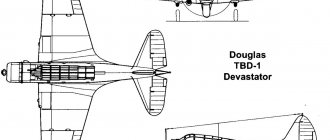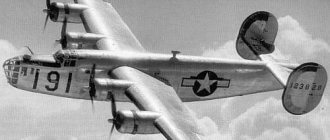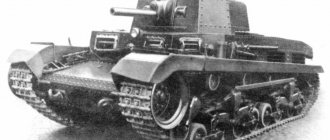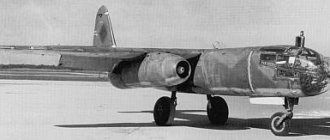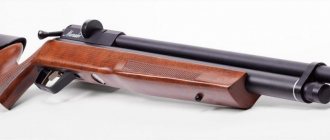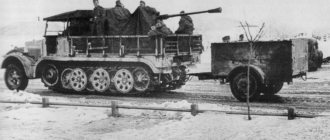The Martin B-26 Marauder, which along with the North American B-25 became the main type of American medium bomber during World War II, was developed in accordance with specification 39-640, which required the future aircraft to have a bomb load of 3000 pounds (1361 kg), range flight 2,000 miles (3,218 km), speed over 300 mph (482 km/h) and ceiling over 20,000 feet (6,100 m). The aircraft's crew was to consist of 5 people, and its defensive weapons were to include at least four 7.62 mm machine guns. Four took part in the competition, North American, Douglas and Stearman. The Martin project under the designation “model 179” was developed by a team led by P.M. Magruder. His aircraft was a monoplane with a high-mounted, low-aspect-ratio wing, a single-tail tail and a retractable tricycle landing gear with a nose gear. The bomber received a streamlined cigar-shaped fuselage with a glazed nose section, made as one piece by hot stamping from plexiglass.
“Model 179” was distinguished by a number of innovative solutions - in particular, about 400 types of plastic parts were used in its design (the aircraft was the first in the history of aviation in which plastics were so widely used). At the same time, when designing the machine, the requirements of mass production were taken into account. The power plant chosen was 18-cylinder air-cooled Pratt & Whitney R-2800-5 Double Wasp engines (1850 hp). The armament, as specified in the specifications, consisted of 4 machine guns - 1 each in the bow and tail mounts and 2 in the upper turret.
In July 1939, the Model 179 project was submitted to the competition committee for consideration. Martin's proposal was recognized as the best compared to competitors, and on August 5, 1939, the company received a contract for the construction of 201 aircraft - immediately serial, without a prototype. The first Martin B-26 was flown on November 25, 1940, and on February 22 of the following year, the first 4 vehicles were transferred to the US Army Air Forces.
The total volume of serial production, which lasted until April 1945, amounted to 5288 aircraft.
Performance characteristics of the Martin B-26 Marauder aircraft
- Engines: Pratt & Whitney R-2800-5
- power, hp: 1850
- Wingspan, m: 19.81
- Aircraft length, m: 17.07
- Aircraft height, m: 6.04
- Wing area, sq. m.: 55.93
- Weight, kg:
- empty aircraft: 9696
- normal takeoff: 12,338
- Maximum speed, km/h: 507
- Climb time 4572 m, min: 12.3
- Ceiling, m.: 7620
- Flight range, km:
- Distillation: 1610
- with a bomb load of 1360 kg: 3540
external reference
- Boger, Joe. "Martin B-26 Marauder." Encyclopedia of American Aircraft
. - Manual: (1945) AN 01-35EB-1 Flight Instructions for Pilots of Army Model B-26B-1 and British -26C (Marauder II) Aircraft.
- "How to Fly a B-26 (1944)" on YouTube.
- The Army asked for a miracle - the answer was the B-26, early 1943 article, photos of early B-26s.]
- Digital collection of the B-26 Marauder at the University of Akron Archives.
- b26.com Website dedicated to the crews who flew the Marauder.
| authoritative control |
|
- Data: Q836438
- Multimedia: Martin B-26 Marauder
Main modifications of the Martin B-26 "Maruder"
B -26 - R-2800-5 engines (1850 hp). Small arms - two 12.7 mm machine guns in the upper turret, two 7.62 mm machine guns in the bow and tail mounts. Bomb load weight - 1360 kg (maximum - 2175 kg). Crew - 5 people. Until October 1941, 201 vehicles were built.
B -26 A - engines R-2800-5 (on the first 30 aircraft) or R-2800-39 (1850 hp). On some vehicles, instead of 7.62 mm machine guns, 12.7 mm machine guns are mounted in the nose and tail mounts. It is possible to install an additional fuel tank in the rear bomb bay. The maximum bomb load weight is 2360 kg. A 1,907-kg torpedo can be suspended on the ventral units. The armor protection has been strengthened and a more advanced type of fuel tank protector has been used. Since October 1941, 139 aircraft have been built. The 52 vehicles transferred to Great Britain were designated Maruder Mk.I.
B -26 V - engines R-2800-5 (on the first 207 aircraft), R-2800-41 (2000 hp; on 95 aircraft) or R-2800-43 (on the rest). The rear fuselage was redesigned and a new tail firing unit with two 12.7 mm machine guns was used. There are 2 12.7 mm machine guns installed in the bow - movable and fixed. From the B-26B-4 series, 2 12.7-mm machine guns were installed in the side windows; some aircraft received 4 of the same fixed machine guns in fairings on the sides of the fuselage. From the B-26V-10 series, the wingspan has been increased by 2 m, and the composition of small arms has been increased to 12 12.7 mm machine guns: 2 each in the upper turret and tail mount, 1 each in the side windows, 1 movable and 1 fixed in the bow parts, 4 fixed in fairings on the sides of the fuselage. Until February 1944, 1,883 aircraft were built at the Middle River plant. The 19 aircraft transferred to the UK were designated Maruder Mk.IA.
B -26 C is an analogue of the B-26B built at the Omaha plant. Engines R-2800-43. The planes had a wing of increased span. From the B-26S-30 series no torpedo suspension units were installed. Since the end of 1942, 1,210 aircraft have been built. The 100 vehicles delivered to the UK were designated Maruder Mk.II.
B -26 F - R-2800-43 engines. The wing angle has been increased and the engine nacelles have been modified. Bomb load weight - 1815 kg. Small arms - 11 12.7 mm machine guns (1 machine gun missing in the bow). Crew - 7 people. Since February 1944, 300 aircraft were manufactured, 200 of them were delivered to Great Britain as the Maruder Mk.NI.
B -26 G is an analogue of the B-26F with a modified composition of on-board equipment and other modifications. Until April 1945, 893 vehicles were built, 150 of them were delivered to Great Britain as the Maruder Mk.HIA. 57 aircraft were made in the unarmed training version of the TB-26G.
AT -23 A and AT -23 B are target towing aircraft based on the B-26B and B-26C, respectively. 208 B-26B and 350 B-26C were converted, in addition, 275 AT-23B were built.
JM -1 and JM -2 are AT-23B and TB-26G, respectively, supplied to the US Navy (for a total of 272 vehicles).
B-29 Superfortress bomber design
The B-29 was an all-metal mid-wing aircraft with a single fin. The fuselage is a semi-monocoque type with a smooth load-bearing skin, structurally consisting of 6 compartments.
Three compartments were sealed: the front cockpit for the pilots and navigator, the middle cockpit for the gunners, and the rear cockpit for the tail machine gun gunner. All three cabins were connected by a common air duct. Behind the cockpit there was an unpressurized bomb bay.
The bomber's wing is straight, trapezoidal in plan, formed by the profile of a Boeing 117. The landing gear is retractable, tricycle with a nose strut. The power plant consisted of 4 air-cooled piston radial engines Wright R-3350 of various modifications. The propellers are four-bladed (three-bladed ones were installed on prototypes).
It should be noted that despite the rather lengthy development of the engines, they remained far from ideal products, had a rather short service life and were unreliable.
Interior of the B-29
Combat use of the Martin B-26 "Marauder"
Photo of Martin B-26 Marauder in flight
Deliveries of B-26s to the US Army Air Forces began in the spring of 1941. The 22nd Bomb Group was the first to receive them, and by the time Japan attacked Pearl Harbor, two more groups were in the process of being retrained for the Maruders - the 38th and 42nd. I. The development of new machines was accompanied by numerous accidents and disasters - the aircraft, packed with technical innovations, turned out to be very demanding in aerobatics. In July 1942, the issue of removing the B-26 from production was even considered. But just at that time, positive reviews about the Maruder began to arrive from the theater of operations, and ultimately production of the aircraft continued.
In February 1942, the 22nd BG was relocated to Hawaii. She was on patrol for about a month, after which she left for Australia. On April 5, 1942, 6 Marauders attacked Rabaul - this was the combat debut of the new bomber. Subsequently, raids on targets in the New Guinea region became the main work for the 22nd group. In September 1942, the 22nd BG took part in the battle for Milne Bay, and in January 1943 it attacked the Japanese bridgehead of Gona-Buna. In November 1942, her Maruders carried out several raids on Timor.
By mid-1942, the 38th BG also arrived in the South Pacific. Its squadrons were stationed in the New Hebrides and Fiji, and most of its combat missions were on reconnaissance and anti-submarine patrols. Beginning in November 1943, she operated more actively on Guadalcanal, completing 63 group raids on coastal and sea targets until mid-February. During 1943, the B-26 was replaced in the 5th VA by the Consolidated B-24 “Liberator” and the North American B-25 Mitchell.
4 B-26s (2 each from the 18th and 69th Air Force) took part in the Battle of Midway. On the morning of June 4, 1942, they attempted a torpedo attack on the aircraft carrier Akagi. And although the torpedoes missed, it was this attack that convinced Admiral Nagumo of the need for a second strike on Midway. The subsequent decision to replace the torpedoes suspended on deck torpedo bombers with bombs was the first in the chain of events that led to the death of Japanese aircraft carriers.
Photo of Martin B-26 Marauder RAF
At the beginning of June 1942, B-26s went into battle in the north - near the Aleutian Islands. The 73rd, 77th and 406th AE stationed here took part in an attempt to repel the Japanese landing, and then in raids on the Japanese-occupied islands of Kiska and Attu. By February 1943, the Marauders were replaced by the B-25.
Quite a significant number of Maruders operated in the 12th VA in North Africa and the Mediterranean. In December 1942, the 319th and 17th BGs arrived in this theater of operations, and in April 1943, the 320th BG. The debut in North Africa was massive - at the beginning of December 1942, all aircraft of the 319th group bombed the positions of Italian-German troops near Sousse (Tunisia) for eight days in a row. On January 3-5, 1943, two groups (about 100 aircraft) carried out raids on the Kairouan-Sus airfield complex. On February 14, B-26s appeared over Italy for the first time - 70 aircraft bombed Decimomannu airfield in Sardinia. Subsequently, until the enemy’s surrender in North Africa, “Maruders” bombed Tunisian airfields almost every day. On May 9, 1943, aircraft from all three B-26 groups took part in a massive raid on the port and warehouses in Palermo. Until June 12, the Maruders systematically attacked targets in Sicily, Sardinia and the island. Pantelleria. There were 20 raids on the last island alone in 2 months. From June 21, 1943, in preparation for the landing in Sicily, the airfields of Trapani, Gerbini, Milo and others were subjected to powerful B-26 attacks.
On July 19, 1943, the Maruders took part in the raid on Rome, forming the second wave of the Allied air force, numbering 300 aircraft. Subsequently, the target areas for the B-26 shifted further and further to the north of the Apennines. At the beginning of 1944, all three Maruder groups moved to Sardinia. Throughout the next year, the B-26 crews carried out monotonous combat work, carrying out systematic raids on Wehrmacht positions and other targets in northern Italy. From August 1944, the 17th and 320th BGs, consolidated into the 42nd Bombardment Wing, supported the landings in southern France and the subsequent Allied advance in the Rhone Valley. In December 1944, the 319th Group rearmed with B-25s, surrendering its Maruders to the French. The 42nd wing in January 1945 was subordinated to the army command - the American 7th Army. Until the end of the war, the main task for his B-26 was direct support of ground forces.
In the spring of 1943, American Maruders appeared in Britain. The 322nd BG arrived here, whose specialization was daylight raids from low altitudes against targets in Western Europe. The first such operation took place on May 14, when 12 B-26s were dispatched to attack the Imuiden power plant in Holland. The result was disastrous - 2 aircraft were shot down, the rest were damaged by anti-aircraft fire, but no damage to the target could be caused. The second raid on the same target, undertaken on May 17, generally ended in defeat - anti-aircraft guns and fighters shot down all 11 Maruders participating in it. After this, it was decided to use the B-26 for attacks from medium altitudes, where small-caliber anti-aircraft guns could not reach them. There was a pause in the combat use of the Maruders, during which three more groups with such aircraft arrived in the UK (323rd, 386th and 387th). All of them were brought together into the 3rd Bomber Wing, which by July 1943 had almost 300 B-26B/C.
B-26 combat missions over Western Europe resumed on July 16, 1943, when 14 aircraft of the 323rd BG bombed an electrical substation near Abbeville. All Maruders returned safely to base. In August, Maruder groups took part in a large-scale air offensive by Allied tactical aviation against railway junctions and airfields in France. At the beginning of September 1943, the American Air Force in England underwent a reorganization - tactical aviation was separated from the 8th VA and merged into the new 9th VA. It also included the 3rd Bomber Wing, which by that time numbered 230 Maruders. Attempts to use the B-26 as night bombers were considered unsuccessful, and from October 1943 they returned to daytime raids. By November, there were already 7 Maruder groups in England, and the 3rd wing had to be divided into two - the 98th and 99th. At the turn of 1943/1944. their planes systematically bombed enemy airfields in France, Belgium and the Netherlands. In addition, more than 1/3 of the combat missions were carried out against the launch positions of V-1 missile aircraft.
The Maruders played a vital role in preparing for the Normandy landings. By May 1944, there were already 10 B-26 groups in England, whose efforts were concentrated in the area of the future landing. Bridges, railway lines, airfields, and coastal batteries were hit. The effectiveness of the raids turned out to be low: by the end of May, the Maruders had not managed to destroy a single bridge or viaduct. On the morning of June 6, about 400 B-26s “processed” the beaches where Allied troops were to land. To increase accuracy, bombing was carried out not from the usual 3500-4000 m, but from 1000 m. The Maruders worked over the bridgeheads until dusk, suppressing pockets of Wehrmacht resistance. In total, B-26s flew 650 combat missions on June 6. In the following days they attacked advancing German reserves.
The successes of the Allied troops made it possible in mid-August 1944 to redeploy the 323rd, 387th, 394th and 397th BGs to France. Their main targets were isolated pockets of resistance on the Atlantic coast of the country, primarily Brest. In December 1944, the Maruders, despite difficult weather conditions, took an active part in repelling the German counter-offensive in the Ardennes. During these fierce battles, 60 Martin B-26 bombers were lost. But constant supplies from the United States made such losses imperceptible: on December 26 and 27, 1944, the 9th VA took 900 Maruders into the air every day.
In 1945, the Martin B-26 gradually began to replace the new Douglas A-26 aircraft. The last combat operation of the Maruders took place on May 3, when 8 B-26G aircraft played the role of target designators for 150 A-26s. In total, in the Western European and Mediterranean theaters of operations, American Maruders carried out almost 130 thousand combat missions, dropping more than 76 thousand tons of bombs. Losses amounted to 911 aircraft.
In the post-war period, three B-26 groups (344th, 394th and 397th) became part of the occupation forces in Germany. Most of the other units were disbanded by the end of 1945. By 1947, there were no more Maruders in service with the US Air Force.
The Maruders were used to a limited extent by the Royal Air Force. Since 1942, they were flown by the 14th AE, based in Egypt and working mainly against naval targets. In March 1943, it was redeployed to Algeria, where part of it was engaged in anti-submarine patrols, and in October 1944, it was returned to the metropolis and rearmed with Wellingtons. In December 1944, the 39th AE received the Maruders. Based in Italy, it provided support for the Yugoslav partisans. This squadron operated Maruders until the beginning of 1946.
Most of the Maruders supplied to Great Britain were transferred to the South African Air Force. They were armed with 5 squadrons participating in the Italian campaign.
Quite a significant number of Martin B-26 Marauders were received by the Free French Air Force, which equipped 6 groups with aircraft of this type. They made their combat debut in 1944, operating in Italy and then in southern France. During the war, French Maruders carried out almost 4.9 thousand combat missions. By 1947 they were withdrawn from service.
“Widowmaker,” “Flying Coffin,” “Baltimore Whore”—these are just a few of the long list of unflattering nicknames given to the Martin B-26 by its crews. The aircraft was considered extremely difficult both in ground handling and in aerobatics - especially during takeoff and landing. This was caused by a very high load on the wing. By increasing its scope, it was possible to somewhat improve the “behavior” of the aircraft, but it was not so easy to destroy established stereotypes. However, if you objectively evaluate the results of the B-26’s combat performance, it turns out that the aircraft was quite good - for example, the level of Maruder combat losses in Europe did not even reach 1%. Nevertheless, the career of the B-26 was short-lived - already during the war it began to be replaced by the simpler and more reliable B-25, and after the victory it was finally replaced by the A-26.
Bibliography
- The Illustrated Encyclopedia of Aviation: Volume 5, pp. 1205–1211, ed. Delta, Barcelona. 1983 ISBN 84-85822-52-8
- Green, William: Famous Bombers of World War II (2nd ed.), Doubleday, N.York, 1975 ISBN 0-356-08333-0.
- Scutts, Jerry: B-26 Marauder units of the Eighth and Ninth Air Forces, Osprey Publishing Ltd., Botley UK, 1997 ISBN 1-85532-637-X.
- Swanborough, Gordon and Bowers, Peter M.: Aircraft of the United States Navy since 1911, Naval Institute Press, Annapolis, USA, 1990 ISBN 0-87021-792-5.
